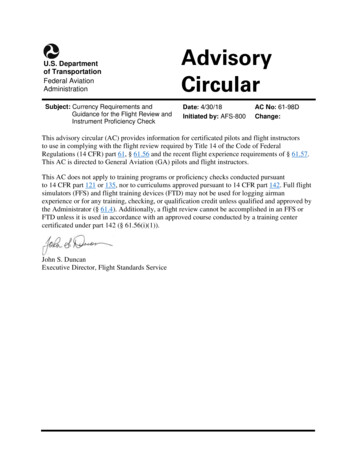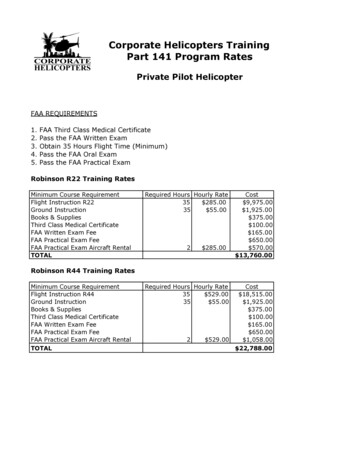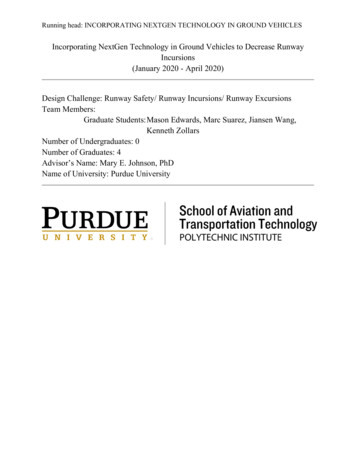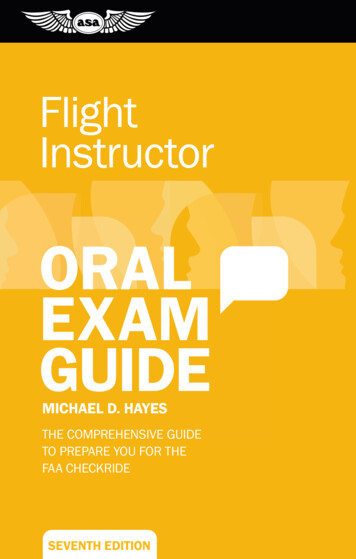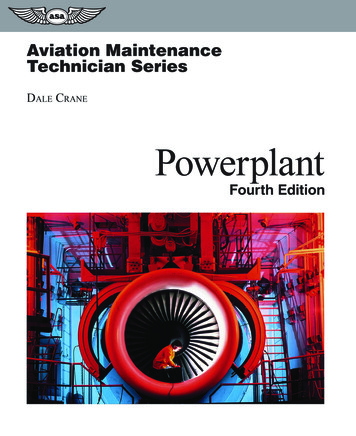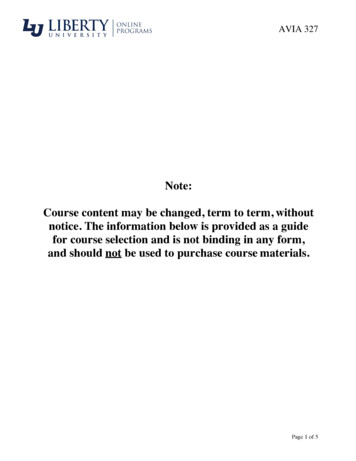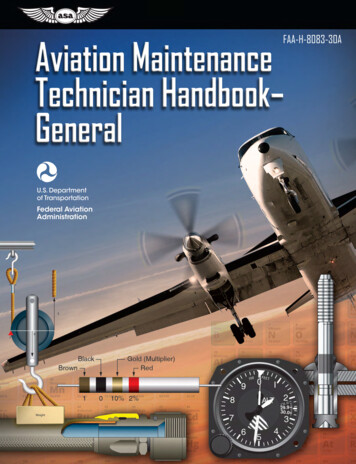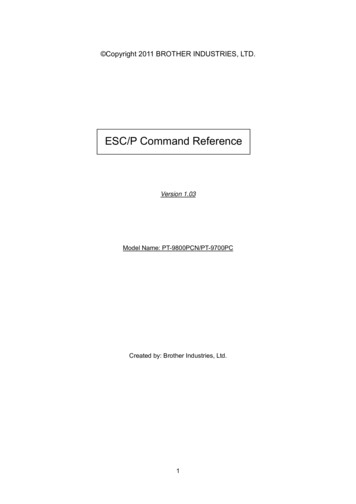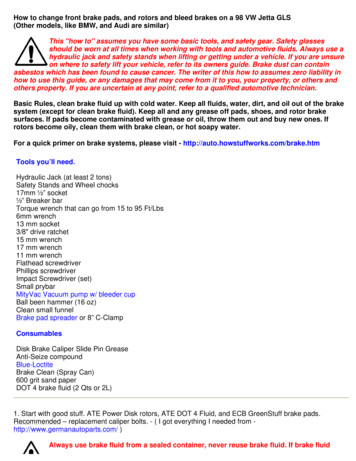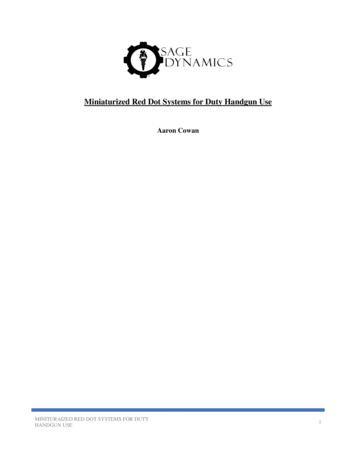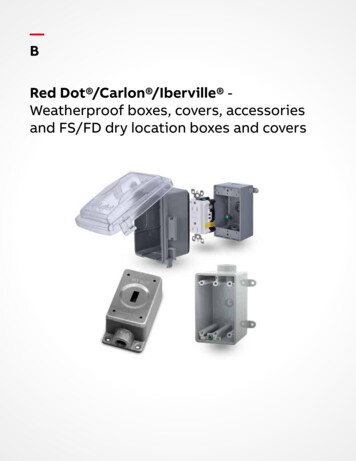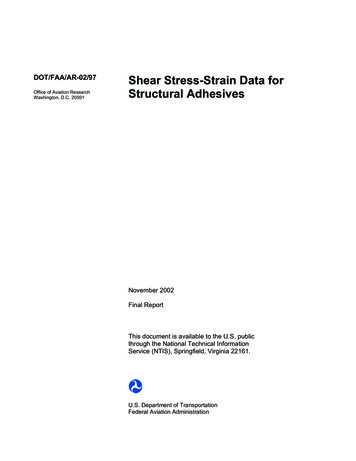
Transcription
DOT/FAA/AR-02/97Office of Aviation ResearchWashington, D.C. 20591Shear Stress-Strain Data forStructural AdhesivesNovember 2002Final ReportThis document is available to the U.S. publicthrough the National Technical InformationService (NTIS), Springfield, Virginia 22161.U.S. Department of TransportationFederal Aviation Administration
NOTICEThis document is disseminated under the sponsorship of the U.S.Department of Transportation in the interest of information exchange.The United States Government assumes no liability for the contents oruse thereof. The United States Government does not endorseproducts or manufacturers. Trade or manufacturer's names appearherein solely because they are considered essential to the objective ofthis report. This document does not constitute FAA certification policy.Consult your local FAA aircraft certification office as to its use.This report is available at the Federal Aviation Administration William J.Hughes Technical Center's Full-Text Technical Reports page:actlibrary.tc.faa.gov in Adobe Acrobat portable document format(PDF).
Technical Report Documentation Page1. Report No.2. Government Accession No.3. Recipient's Catalog No.DOT/FAA/AR-02/974. Title and Subtitle5. Report DateSHEAR STRESS-STRAIN DATA FOR STRUCTURAL ADHESIVESNovember 20026. Performing Organization Code7. Author(s)8. Performing Organization Report No.John Tomblin, Waruna Seneviratne, Paulo Escobar, and Yap Yoon-Khian9. Performing Organization Name and Address10. Work Unit No. (TRAIS)Department of Aerospace EngineeringWichita State UniversityWichita, KS 6726011. Contract or Grant No.00-C-WSU-00-00712. Sponsoring Agency Name and Address13. Type of Report and Period CoveredU.S. Department of TransportationFederal Aviation AdministrationOffice of Aviation ResearchWashington, DC 20591Final Report14. Sponsoring Agency CodeACE-11015. Supplementary NotesThe FAA William J. Hughes Technical Center COTR was Peter Shyprykevich.16. AbstractThe main objective of this investigation was to generate characteristic shear responses for several adhesives used for aerospacestructural bonding applications. The shear responses consisted of shear stress-strain curves obtained by standardized tests andcharacterizing subsequent failure modes at three different environmental conditions. Six of these adhesives were film and theremaining were paste adhesive. In addition, the effects of heat and humidity on the apparent shear strength, shear modulus, andfailure modes of each adhesive were investigated by testing at elevated temperatures with humidity-conditioned specimens. Thecharacteristic shear responses were generated using the ASTM D 5656 thick adherend test method. The primary purpose of thisreport was to make this data available for use in future design and modeling efforts.17. Key Words18. Distribution StatementAdhesive properties, Shear response, Environmental effects,ASTM D5656, KGR-Type extensometerThis document is available to the public through the NationalTechnical Information Service (NTIS), Springfield, Virginia22161.19. Security Classif. (of this report)UnclassifiedForm DOT F1700.720. Security Classif. (of this page)Unclassified(8-72)Reproduction of completed page authorized21. No. of Pages6022. Price
ACKNOWLEDGEMENTThe authors would like to acknowledge the guidance and support of Peter Shyprykevich andLarry Ilcewicz of the Federal Aviation Administration, and Cessna Aircraft Company and CirrusDesign Corporation for supplying materials.iii/iv
TABLE OF CONTENTSPageEXECUTIVE und2.ADHESIVES13.TEST MATRIX34.PANEL FABRICATION AND MACHINING44.14.2485.EXPERIMENTAL PROCEDURE5.15.25.35.45.56.Adhesive Test Panel FabricationMachining of ASTM D 5656 Lap Shear Adhesive Specimens9Specimen Conditioning and DimensioningTest SetupModified KGR-Type ExtensometerData ReductionFailure Modes of Adhesive Joints99101012RESULTS AND DISCUSSION126.16.26.3131320Film AdhesivesPaste AdhesivesFailure teristic Shear ResponsesB—Adhesive Apparent Shear Strength and Modulus With Respect to the EnvironmentC—Failure Modes With Respect to the Environmentv
LIST OF FIGURESFigurePage1Spacer Locations for Paste Adhesive Test Panels52Paste Adhesive Application for ASTM D 5656 Test Panels63Vacuum Bagging Adhesive Test Panels64Cure Cycle Information Adhesive Systems Used in Task 175Nomenclature for Adhesive Test Specimens86Test Setup for ASTM D 5656 Adhesive Lap Shear Test97Modified KGR-Type Extensometer (Four-Pin Configuration) for MeasuringAdhesive Shear Strain108Typical Shear Stress-Strain Curve for Adhesives119Failure Modes of Adhesive Test Specimens1210Environmental Effects on Shear Strength of Film Adhesives1611Environmental Effects on Shear Strength of Paste Adhesives1712Environmental Effects on Shear Modulus of Film Adhesives1813Environmental Effects on Shear Modulus of Paste Adhesives19LIST OF TABLESTable123PageTest Matrix for Task 1Average Shear Strength and Shear Modulus for Film AdhesivesAverage Shear Strength and Shear Modulus for Paste Adhesivesvi41415
EXECUTIVE SUMMARYThe main objective of this investigation was to generate characteristic shear responses for severaladhesives used for aerospace structural bonding applications. The shear responses consisted ofshear stress-strain curves obtained by standardized tests and characterizing subsequent failuremodes at three different environmental conditions. Six of these adhesives were film and theremaining were paste adhesive. In addition, the effects of heat and humidity on the apparentshear strength, shear modulus, and failure modes of each adhesive were investigated by testing atelevated temperatures with humidity-conditioned specimens. The characteristic shear responseswere generated using the ASTM D 5656 thick adherend test method. The primary purpose ofthis report was to make this data available for use in future design and modeling efforts.vii/viii
1. INTRODUCTION.1.1 OBJECTIVES.The main objective of this investigation was to generate characteristic shear responses for severaladhesives used for aerospace structural bonding applications. This task involved generatingcharacteristic shear stress-strain data at three different environmental conditions: roomtemperature dry (RTD), elevated temperature dry (ETD), and elevated temperature wet (ETW).This study generated characteristic shear responses for 18 different adhesive systems that arecurrently being investigated for use in manufacturing applications, as well as several that havebeen used historically in aircraft primary structural bonding. Six of these adhesives were filmand the remaining were paste. In addition, the effects of heat and humidity on the apparent shearstrength, shear modulus, and failure modes of each adhesive were investigated.1.2 BACKGROUND.The motivation for this study was the increased use of adhesive bonding in construction ofgeneral aviation aircraft. Additional impetus was to study the effects of elevated temperature onadhesive behavior as lower cure temperature (than previous military applications) is being usedin such constructions. The adhesive strength and modulus were determined according to ASTMD 5656 (Standard Test Method for Thick-Adherend Metal Lap-Shear Joints for Determination ofthe Stress-Strain Behavior of Adhesives in Shear by Tension Loading [1]). Testing wasconducted in three different environmental conditions: RTD, ETD ( 180 F), and ETW( 180 F). The substrate material, provided by Cessna Aircraft Company of Wichita, Kansas,was phosphorically anodized 2024-T3 aluminum. Using the ASTM D 5656 test method, theeffects of environment on the aircraft or subcomponent-bonded joint may be determinedquantitatively. Combining this type of information with a thermal model for the aircraft will aidfuture designers in selecting the correct joint application in combination with the environmentalexposure to be expected. The adhesive shear deformation was measured using two modifiedKGR-type port and starboard extensometers.Thick adherend, recommended in ASTM D 5656, reduces the peel stress of lap joint specimens;therefore, test results may not represent the actual adhesive joint behavior. However, thismethod can be used to generate characteristic shear stress-strain curves and evaluate adhesiveproperties rather than adhesive joint properties. It should be noted that, although this test methodis in common use, the method is very complicated, requiring careful specimen preparation, loadintroduction, and sensitive measurement instruments. One of the main purposes of this reportwas to present this information to allow one to do analysis of bonded joints (including nonlineareffects) and establish relevant failure models for structural joints in the future. This report alsoprovides useful information for ongoing certification issues related to the application of lowertemperature cure adhesive systems.2. ADHESIVES.To select the adhesives used for this investigation, several general aviation companies andpersonnel from the Federal Aviation Administration were consulted. Adhesives were suppliedby Cessna Aircraft Company of Wichita, Kansas, and Cirrus Design Corporation of Duluth,1
Minnesota. Some general information about various adhesives obtained from material vendorsand aircraft companies is listed below. Film AdhesivesAF 126 – First generation epoxy film adhesive used in the aerospace industry for morethan 30 years, thermosetting and nonvolatile for structural bonding of metals,excellent strength with a high degree of tack in the uncured state.EA 9628 – Modified epoxy film adhesive designed for structural bonds requiringtoughness, as applied in composite, metal, and honeycomb bonding.EA 9695 – Bonding film adhesive with excellent environmental resistance used incomposites structural repair, cure and cocure with composite laminates, andmetal and honeycomb bonding.EA 9696 – Moisture-resistant modified epoxy film used in composites structural repair,cure and cocure with composite laminates, and metal and honeycombbonding; some space applications designed to withstand extremes oftemperature, such as assemblies in the International Space Station.FM 300 – 350 F cure structural adhesive used in the aerospace industry for more than 30years in metal-to-metal and composite bonding.FM 73 – Fracture-tough modified epoxy adhesive used in bonded repairs, and metal-tometal and composite bonding applications, typically cured at 250 F for 1 hour;used in the U.S. Air Force’s successful Primary Adhesively Bonded StructuresTechnology (PABST) program in the 1970s and currently used in bondedcomposite repair of cracked metallic aerospace structures, operationaltemperatures up to 180 F. Paste AdhesivesEA 9309.3 NA – Two-component paste-toughened adhesive with excellent peel strengthcontaining 5 mil/0.13 m glass beads for bond line thickness control.EA 9346.5 – One-component paste adhesive with a moderate viscosity, high-peel andshear strengths, and outstanding hot/wet properties for structural repairs,low viscosity wet layups, composite bonding, etc.EA 9359.3 – Two-component paste adhesive system with excellent peel strength forbonding a variety of substrate materials and for structural repairs.EA 9360 – Structural adhesive exhibiting excellent peel strength used for structuralrepairs, composite bonding, and liquid shim; service temperature up to300 F.2
EA 9392 – Toughened adhesive with excellent shear strength at high temperatures anddurable over a wide temperature range used for structural repair, potting,composites bonding, liquid shim, etc; service temperature up to 350 F.EA 9394 – Thixotropic adhesive with structural properties up to 350 F and a low peelstrength used for potting, structural repair, composite bonding, liquid shim,and metal-composite bonding, i.e., titanium end fittings to composite parts.EA 9396 – Low viscosity adhesive with structural properties up to 350 F used forstructural repair, composite bonding, and low viscosity wet layups.3M DP-460 EG – Two-component epoxy adhesive with a low outgassing for potting,magnet bonding, hard disk drive assembly, bearing cartridge assembly(nontypical for aerospace structural bonding).3M DP-460 NS – Two-component non-sag epoxy adhesive with an outstanding shear andpeel at RTD, and high level of durability; non-sag formulation isexcellent for vertical applications or any application requiring minimaladhesive flow from the bond line.3M DP-820 – Two-component toughened acrylic adhesive with excellent shear and peelstrength at RTD, good impact resistance and durability; bonded well tomany metals, ceramics, wood, and most plastics; non-sag with 20 minutework-life.3. TEST MATRIX.The test matrix includes specimens in three different environmental conditions: RTD, ETD 180 F, and ETW 180 F. Two different cure cycles were investigated for EA 9360, EA 9392,and EA 9359.3 paste adhesives. A second cure cycle, similar to the first, was performed for anadditional 48 hours under ambient conditions. Two replicates were proposed for eachenvironmental condition. Testing was conducted according to the guidelines in ASTM D 5656.The thick adherend test method was used to minimize the peel stress from asymmetric loading.Table 1 shows the test matrix for eighteen different adhesive systems, including the six film andtwelve paste adhesives.3
TABLE 1. TEST MATRIX FOR TASK 1Adhesive NameAF 126FM 73EA 9628EA 9696EA 9695FM 300EA 9346.5EA 9309.3 NAEA 9394EA 93963M DP-460 NS3M DP-460 EG3M DP-820EA 9360EA 9392EA 9359.3MGS L418PTM&W ES 6292TOTALCureCycle111111111111112121211Number of Coupons per Test 2222222222222222222222222222222424242RTD – Room Temperature Dry (76 F) Testing ConditionETD – Elevated Temperature Dry (180 F) Testing ConditionETW– Elevated Temperature Wet (180 F) Testing Condition4. PANEL FABRICATION AND MACHINING.4.1 ADHESIVE TEST PANEL FABRICATION.Specimens were fabricated according to the guidelines in the ASTM D 5656 standard. Testpanels were fabricated using two 10- x 10-inch subpanels with a thickness of 0.375 inch,phosphoric-anodized and bond-primed, following ASTM D 3933, by Cessna Aircraft Companyof Wichita, Kansas. The side with minimal surface scratches, especially in the test area, wasselected to contact with the adhesive. On that face, two parallel lines were drawn 0.5 inch awayfrom the centerline and perpendicular to the grain direction (figure 1). On the other face, 12reference points were marked, and the thickness at each point was measured using a digitalmicrometer.4
FIGURE 1. SPACER LOCATIONS FOR PASTE ADHESIVE TEST PANELSSubpanels were grouped into sets of two, and reference points were marked so that bonded testpanels would have the same reference point on both sides. Subpanel surfaces were cleanedseveral times with acetone and lint-free cotton towels, using a sweeping motion in the directionof the grain. This step in the process is important to ensure that the surface is adequatelyprepared for proper bonding of the aluminum-adhesive interface. Care was taken not to scratchthe surface but to remove grease and other foreign substances. This procedure was repeated atleast once to produce a clean surface. Poorly cleaned surfaces increase the chance of failure inan adhesive specimen, due to voids in the aluminum-adhesive interface.Panels for six different film adhesives and twelve different paste adhesives were fabricated. Toachieve a constant bond line thickness, brass shims/spacers were placed in specific areas usingan aluminum template designed to position the spacers between specimens and the panel border.Care was taken not to leave any spacers in the gauge section. Once locations were marked usingthe template, spacers were bonded to the aluminum plate using either liquid glue (super glue) ordouble-sided tape. Following several iterations, the double-sided tape was found to provide amore even distribution of thickness than liquid glue. After the spacers were bonded, thissubpanel surface was cleaned again with acetone.Paste adhesives were applied in two different methods. Typically, the resin and accelerator weremixed in a cup using a prescribed mix-ratio and then applied to the subpanel. Another methodused adhesives that were supplied in premeasured dual-syringe plastic Duo-Pak cartridges andthen inserted into an applicator system. A nozzle attached to each applicator automaticallymixed parts A and B. Each time a new cartridge was used, a small amount of adhesive wasexpelled before applying the remaining resin over the panel to avoid the use of any unmixedresin. Care was taken to evenly distribute the adhesive over the subpanel with the spacers andespecially over the gauge section (figure 2). A thin layer of adhesive was applied over a secondsubpanel to provide a wet surface and diminish potential voids in the adhesive-aluminuminterface. Immediately after that, the second subpanel was tilted and placed over the firstsubpanel to expel any trapped air.5
FIGURE 2. PASTE ADHESIVE APPLICATION FOR ASTM D 5656 TEST PANELSFor film adhesives, the required number of layers were cut and placed on one subpanel. Afterpositioning each layer, the entire structure was rolled using a rubber roller to expel the trappedair between the surface and the film. To maintain a constant bond line thickness, a rectangularopening was cut in each layer to accommodate the spacers, using the same spacing template as inthe paste adhesive panels.Once the adhesive was applied, subpanels were taped with flash breaker tape to avoid anymovement during the cure cycle. To ensure both plates were entirely closed, 4000 psi ofpressure was applied using a 150-ton pneumatic press for 5 to 6 minutes. The plates were thenvacuum bagged and maintained at an integrity of 27-in Hg (figure 3).Each adhesive was cured according to the specified temperature and pressure obtained from themanufacturers data sheet (figure 4). A 3′ x 5′, 1000 F, 400-psi autoclave was used to regulatethe cure process. The temperature control thermocouple monitored the adhesive temperature.FIGURE 3. VACUUM BAGGING ADHESIVE TEST PANELS6
AdhesiveFilm AdhesivesCure Temperature Range73ºF120 F160ºF180ºF200 F245ºF260ºF345ºF360ºF60-90 minutes60-90 minutes60-90 minutes60-90 minutesAF 126EA 9628EA 9695EA 9696FM300 (U065004)FM73 (U064164)60-90 minutes60-90 minutes7Paste Adhesives90-120 minutesEA 9309.3 NAEA 9346.590-120 minutesEA 9394 (U000941)90-120 minutesEA 9396 (U000940)7 days3M DP-460 NS24 hrs3M DP-460 EG48 hrs3M DP-8201 hour PTM&W ES 62923 hours MGS L418/41860 minEA 9360 (CC1)30 minEA 9360 (CC2)**60 minEA 9392 (CC1)30 minEA 9392 (CC2)**60 minEA 9359.3 (CC1)30 minEA 9359.3 (CC2)**PostCure:5hoursat180 -200 F Post Cure: 10 hours at 175 -200 F** Additional 48 hours at ambient temperature after cure cycleCC (Cure Cycle)Cure MethodAutoclave Oven Vacuum50-55 psiBag 22 HgRoomTemp.aaaaa60-90 minutesFIGURE 4. CURE CYCLE INFORMATION ADHESIVE SYSTEMS USED IN TASK 1aaaaaaaaaaaaaaa
Once the panels were cured, the final thickness was measured at the reference points in order tocalculate the bond line thickness, which was used in two of the machining steps, discussed in thenext section.4.2 MACHINING OF ASTM D 5656 LAP SHEAR ADHESIVE SPECIMENS.Adhesive lap shear specimens were machined according to the recommendations of ASTMD 5656 using a Bridgeport CNC machine. Tool paths were created using MasterCam Version7. First, the 1/2-inch loading pinholes were drilled and reamed with a 0.51-in reamer using theCNC machine, and panels were rough-cut into 1.25-in-wide strips using a band saw. These werecut oversized to avoid overheating and stressing of the adhesive, which can alter adhesiveproperties. Next, the specimen was machined (surface ground) to the final dimensions specifiedin ASTM D 5656. Eighth-in slots were made across the width of the specimen, resulting in a0.375-in gauge section. Finally, 1/16-in pinholes were drilled on both sides of the gage sectionfor the KGR-type extensometer attachment. CNC machining was conducted with abundantcoolant to ensure that the specimens were not overheated during the machining process.Following machining, for the purpose of tracking, specimens were named using thenomenclature shown in figure 5.XXXX X XXXTest ConditionA – RTDG – ETD (180 F)F – ETW (180 F)ADHESIVE SYSTEMABCDEFG- AF 126- AF 163- EA 9628- EA 9695- EA 9696- FM 300- FM 73LMNOPQRSTUVW- EA 9309.3 NA- EA 9346.5- EA 9359.3- EA 9360- EA 9392- EA 9394- EA 9396- MGS L418- PTM&W ES6292- 3M DP-460 EG- 3M DP-460 NS- 3M DP-820Cure Cycles1 – 2 AccordinglySpecimen Number1 – 7 per PanelPanel Number1 – 3 per Adhesive systemBond line Thickness/10010 – 56 AccordinglyAdhesive TypeF – FilmP – PasteFIGURE 5. NOMENCLATURE FOR ADHESIVE TEST SPECIMENS8
5. EXPERIMENTAL PROCEDURE.5.1 SPECIMEN CONDITIONING AND DIMENSIONING.Wet test specimens (ETW) were conditioned at 145 F and 85% relative humidity for 1000 hours(approximately 42 days) [2] in a humidity chamber in the NIAR Composites Laboratory atWichita State University, Wichita, Kansas. Prior to this, ETW were dimensioned using digitalcalipers that automatically recorded the dimensions in a data file. Two gage-width readings andtwo gage-length readings were recorded. In addition, the adhesive thickness was calculated bysubtracting the subpanel thickness obtained before specimen fabrication from the panel thicknessafter final fabrication.5.2 TEST SETUP.Adhesive lap shear testing was conducted according to the recommendations in the ASTMD 5656 standard (see figure 6). All testing was done in tension loading in the displacementcontrol mode. Two self-aligning clevis fixtures were used at each end of the specimen to load itin tension. Half-inch steel bushings were inserted into the loading holes of the specimen, and0.375″ steel dowel pins were used to attach the specimen to the clevis arrangement. Experimentswere performed on 22-kip MTS servohydraulic load frames at a rate of 0.05 in/min. Elevatedtemperature testing was conducted using a computer-controlled environmental chamber. Thetemperature of the chamber was monitored with a thermocouple taped to the gauge section of thespecimen. Soak time for ETD and ETW specimens was 3 minutes after the gauge sectionreached the test temperature. The temperature was maintained within 3 F of the targeted valueof 180 F.FIGURE 6. TEST SETUP FOR ASTM D 5656 ADHESIVE LAP SHEAR TEST9
The displacement of the gauge section was recorded using two axial extensometers modified tofunction as KGR-type extensometers with four pin configurations. A detailed description of theKGR-type extensometer is discussed in the next section.5.3 MODIFIED KGR-TYPE EXTENSOMETER.The KGR extensometer [3] was modified to accommodate various bond line thicknesses. Twoaluminum parts were attached to each arm of a MTS extensometer (figure 7). A fourth pin wasadded to the original KGR extensometer design to reduce the rotation and slippage of theextensometer attachment caused by peeling stresses [4 and 5]. The KGR-type extensometer usedin this investigation was modified with knife edges so that extra calibration was not necessary.As the specimen extended in the loading direction, the knife edges allowed the extensometerarms to rotate so that the pins stayed perpendicular to the specimen.FIGURE 7. MODIFIED KGR-TYPE EXTENSOMETER (FOUR-PINCONFIGURATION) FOR MEASURING ADHESIVE SHEAR STRAIN5.4 DATA REDUCTION.Data reduction was performed according to the ASTM D 5656 test standard. The apparent shearstress, τi, on the adhesive at each point was calculated using equation 1 below.τ i Pi A(1)where Pi is the axial load and A is the initial overlap area (overlap length times width). The nextstep in the process was to find the adhesive shear strain. A correction for the displacement of theadherend that occurred between the pins and the adherend/adhesive interface, δm, was found byusing equation 2,δm p tLMFap100010(2)
where p is the average point gap and t is the bond line thickness. M is the metal displacement at1000 lbf, as found in the all-aluminum dummy sample [1 and 4], and L is the load atdisplacement δa. Fa is the relationship between the all-aluminum correction factor and thesimulated bond line thickness for tsimulated given by equation 3a or 3b [6].Fa 1.73t simulated 1.065 [t inches](3a)Fa 0.0683 t simulated 1.065 [t mm](3b)The shear strain, γi, at each point is calculated using equation 4, taken from the ASTM D 5656standard, assuming a small-angle theory,γi δa δm(4)twhere δa is the measured displacement of the KGR-type extensometer and δm is the ASTMcorrection factor for the adherend displacement that occurs between the measuring points and theadherend/adhesive interface.The slope of the shear stress-strain curve in the initial linear range (figure 8) is the adhesive shearmodulus, G. The adhesive shear modulus is found byG τ γ(5)where τ is the adhesive shear stress variation in the linear range and γ is the adhesive shearstress variation in the linear range. To find the initial shear modulus from the adhesive shearstress-strain graph, a curve fit was applied to the initial linear section of the stress-strain curve.This is illustrated in figure 8, where the data points for the average reading of both KGR-typedevices was curve fit. The slope of this line is defined as the adhesive shear modulus, G, in thisreport.6000Shear Stress (psi)500040003000Y M*X C2000100000.00.20.40.60.81.01.2Shear StrainFIGURE 8. TYPICAL SHEAR STRESS-STRAIN CURVE FOR ADHESIVES11
As seen from figure 8, one of the most distinguishing features of the test results using the ASTMD 5656 test method is the ability to characterize the adhesive shear response in the nonlinearrange. These nonlinear results are extremely hard or impossible to obtain using other standardtest methods and make the data presented in the report very valuable. This nonlinear data isneeded for analytical models to predict failure of bonded joints.5.5 FAILURE MODES OF ADHESIVE JOINTS.To gain a full understanding of the properties of the adhesive and the joint being investigated, themode of failure must be characterized. In adhesive technology, there are three typicalcharacterizations for the failure mode of an adhesive joint (figure 9). Cohesive failure is characterized by failure of the adhesive itself. Adhesive failure is characterized by a failure of the joint at the adhesive/adherendinterface and is typically caused by inadequate surface preparation, chemically and/ormechanically. Specimens that fail adhesively tend to have excessive peel stresses thatlead to failure and often do not yield a strength value for the adhesive joint but ratherindicate unsuitable surface qualities of the adherend. Substrate failure is characterized by failure of the adherend instead of the adhesive. Inmetals, this occurs when the adherend yields. In composites, the laminate typically failsby way of interlamina failure, i.e., when the matrix between plies fails. In substrates,failure occurs when the adhesive is stronger than the adherend in the joint being tested.FIGURE 9. FAILURE MODES OF ADHESIVE TEST SPECIMENS6. RESULTS AND DISCUSSION.The apparent shear strength and shear modulus results for film and paste adhesives aresummarized in tables 2 and 3, respectively. These results reflect the average value obtained from12
two or three replicates. Figures 10 through 13 illustrate the apparent shear strength and shearmodulus results for various adhesives. The details of the results presented in figures 10-13 arepresented in appendix A, which show the characteristic stress-strain curves of each individualtest. The results presented in appendix A are the primary goal of this report and are merelysummarized on a comparative basis in figures 10-13. Appendix B shows a similar summarywhich presents the results from tables 2 and 3 in a graphical format for each adhesive.The apparent shear strength and shear modulus indicated a significant decrease as the adhesiveswere exposed to heat and moisture. The environmental effects on these two adhesive propertiesfollow the general trend, RTD ETD ETW, which was observed in previous experimentaldata [4].Some of the shear modulus results were not reported, due to excessive vibration in extensometerdata; consequently, additional specimens were tested. The following sections summarize theresults for film and paste adhesives.6.1 FILM ADHESIVES.Panels for AF 126, EA 9628, FM 73, and FM 300 were fabricated with spacers to provide aneven thickness distribution. For the thick bond lines, the use of spacers is imperative to obtain auniform baseline. Except for FM 73 (RTD) where the strengths were equal, thinner bond linesproduced higher shear strength results than thicker bond lines. This agrees with the datapresented in reference 4. When compared to RTD conditions, the shear strength of EA 9628 filmadhesives had the least reduction (8.7%) at ETD, while the shear modulus of EA 9695 had theleast reduction (17.6%) at ETD. The FM 300 adhesive system performed better at both ETD andETW conditions compared to others selected in this investigation. In addition, the shear strengthof FM 300 at RTD conditions was the highest (6.8 ksi), and the shear modulus was 0.142 Msi.Shear strength and modulus results for FM 73 were among the lowest test values obtained in thisinvestigation. Even though AF 126 had higher values under RTD conditions, it had the lowesttest results under ETD and ETW conditions. Compared to RTD conditions, shear strength of AF126 under RTD and ETW conditions dropped 38.4% and 80.2%, respectively. The shearmodulus of AF 126 under ETD and ETW conditions also dropped 82.3% and 98%, respectively.As bond line thickness increased, failure modes indicated greater adhesive failure and asignificant drop in apparent shear strength for all environmental conditions. EA 9628 fai
FM 300 - 350 F cure structural adhesive used in the aerospace industry for more than 30 years in metal-to-metal and composite bonding. FM 73 - Fracture-tough modified epoxy adhesive used in bonded repairs, and metal-to-metal and composite bonding applications, typically cured at 250 F for 1 hour;
